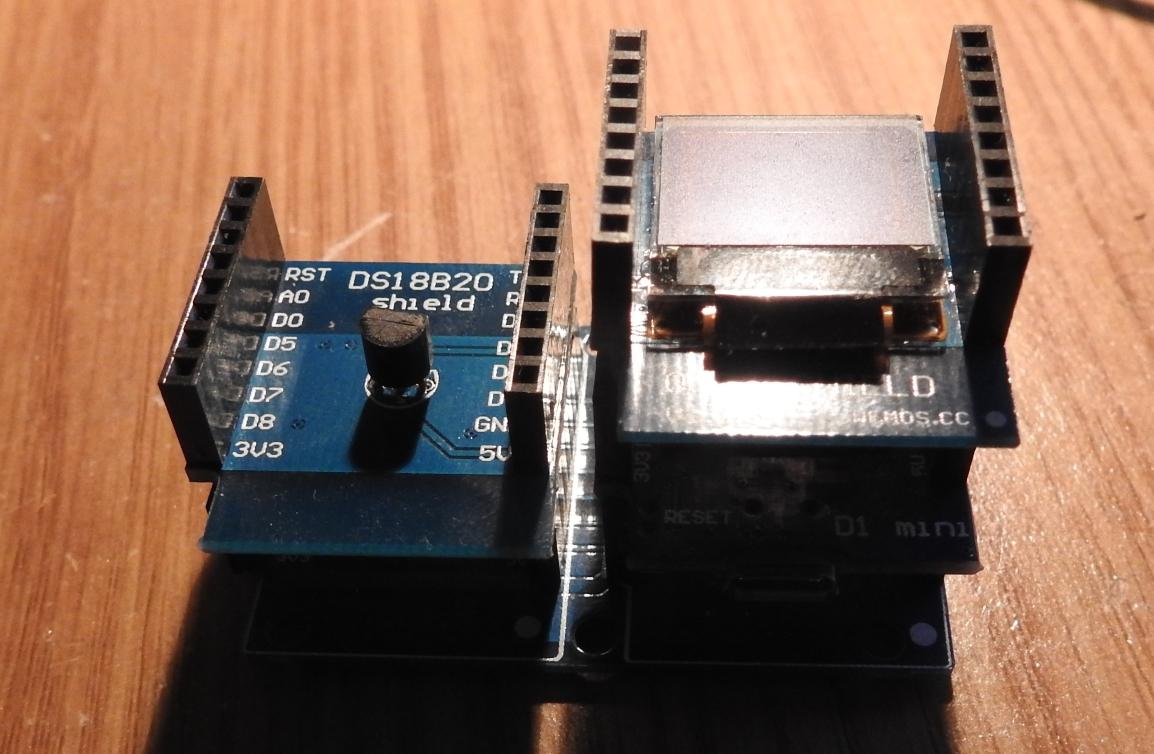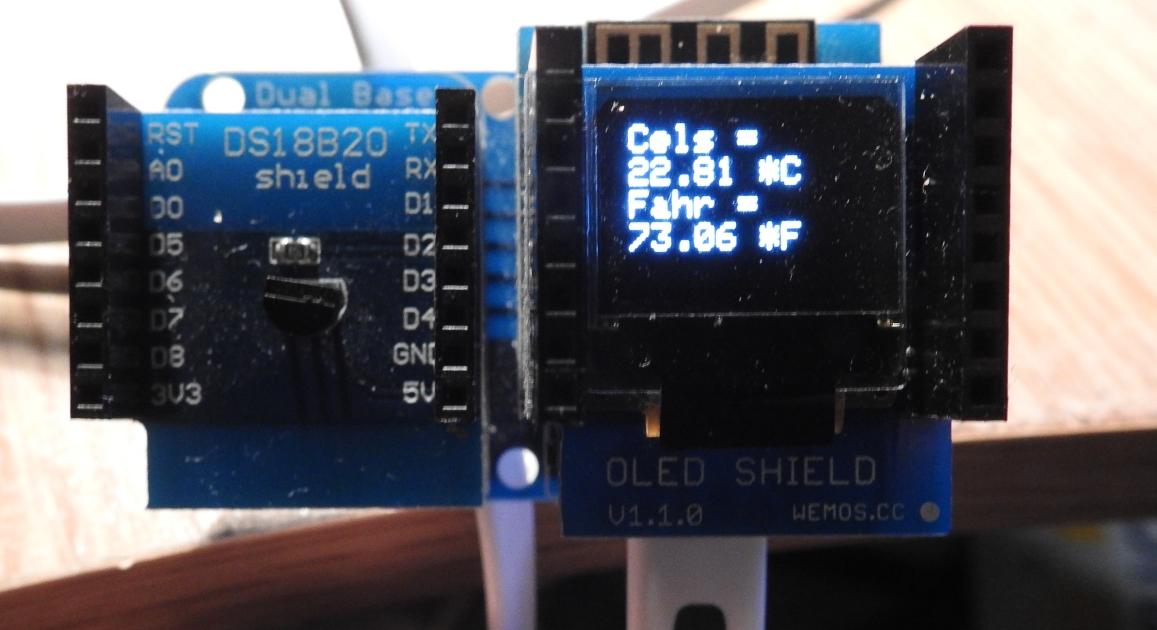In this particular example we are going to simply display temperature. pressure and altitude readings from a DS18B20 sensor on an OLED display.
These are all the shields used in making this a simple project to build.
Parts Required
Here are the parts I used
| Name | Links | |
| Wemos Mini | ||
| DS18B20 | ||
| Connecting cables |
1 x Wemos Mini
1 x Wemos Dual Base
1 x OLED Shield
1 x DS18B20 Shield (not an official Wemos Shield)
You can see what I assembled in the picture below, I could have stacked in one column but I wanted to see the OLED and also leave the BMP180 uncovered.

Code
2 libraries required – you can install these via the library manager, here are links to them
https://github.com/sparkfun/SparkFun_Micro_OLED_Arduino_Library
https://github.com/PaulStoffregen/OneWire
#include <OneWire.h>
#include <SFE_MicroOLED.h> // Include the SFE_MicroOLED library
#define PIN_RESET 255 //
#define DC_JUMPER 0 // I2C Addres: 0 - 0x3C, 1 - 0x3D
// OneWire DS18S20, DS18B20, DS1822 Temperature Example
OneWire ds(D2); // on pin D2 (a 4.7K resistor is necessary)
MicroOLED oled(PIN_RESET, DC_JUMPER); // Example I2C declaration
void setup(void)
{
Serial.begin(9600);
oled.begin();
oled.clear(ALL); // Clear the display's memory (gets rid of artifacts)
oled.display();
}
void loop(void)
{
byte i;
byte present = 0;
byte type_s;
byte data[12];
byte addr[8];
float celsius, fahrenheit;
if ( !ds.search(addr))
{
ds.reset_search();
delay(250);
return;
}
if (OneWire::crc8(addr, 7) != addr[7])
{
Serial.println("CRC is not valid!");
return;
}
// the first ROM byte indicates which chip
switch (addr[0])
{
case 0x10:
type_s = 1;
break;
case 0x28:
type_s = 0;
break;
case 0x22:
type_s = 0;
break;
default:
Serial.println("Device is not a DS18x20 family device.");
return;
}
ds.reset();
ds.select(addr);
ds.write(0x44, 1); // start conversion, with parasite power on at the end
delay(1000);
present = ds.reset();
ds.select(addr);
ds.write(0xBE); // Read Scratchpad
for ( i = 0; i < 9; i++)
{
data[i] = ds.read();
}
// Convert the data to actual temperature
int16_t raw = (data[1] << 8) | data[0];
if (type_s) {
raw = raw << 3; // 9 bit resolution default
if (data[7] == 0x10)
{
raw = (raw & 0xFFF0) + 12 - data[6];
}
}
else
{
byte cfg = (data[4] & 0x60);
if (cfg == 0x00) raw = raw & ~7; // 9 bit resolution, 93.75 ms
else if (cfg == 0x20) raw = raw & ~3; // 10 bit res, 187.5 ms
else if (cfg == 0x40) raw = raw & ~1; // 11 bit res, 375 ms
}
oled.clear(PAGE);
oled.setFontType(0); // set font type 0, please see declaration in SFE_MicroOLED.cpp
oled.setCursor(1, 3);
celsius = (float)raw / 16.0;
fahrenheit = celsius * 1.8 + 32.0;
oled.print("Cels = ");
oled.setCursor(1, 12);
oled.print(celsius);
oled.print(" *C");
oled.setCursor(1, 21);
oled.print("Fahr =");
oled.setCursor(1, 30);
oled.print(fahrenheit);
oled.print(" *F");
oled.display();
}
Output
Here you can see the output

Links
You can get all the boards and shields for about $10
Mini NodeMcu 4M bytes Lua WIFI Internet of Things development board based ESP8266 by WeMos
Double Socket Dual Base Shield for WeMos D1 Mini NodeMCU ESP8266 Diy PCB D1 Expansion board
64X48 IIC I2C LCD OLED LED Dispaly Shield for Arduino Compatible WeMos D1 Mini
DS18B20 temperature sensor module measurement module FOR WeMos D1 mini WIFI extension board

How display temperature on web using wemos arduino ?